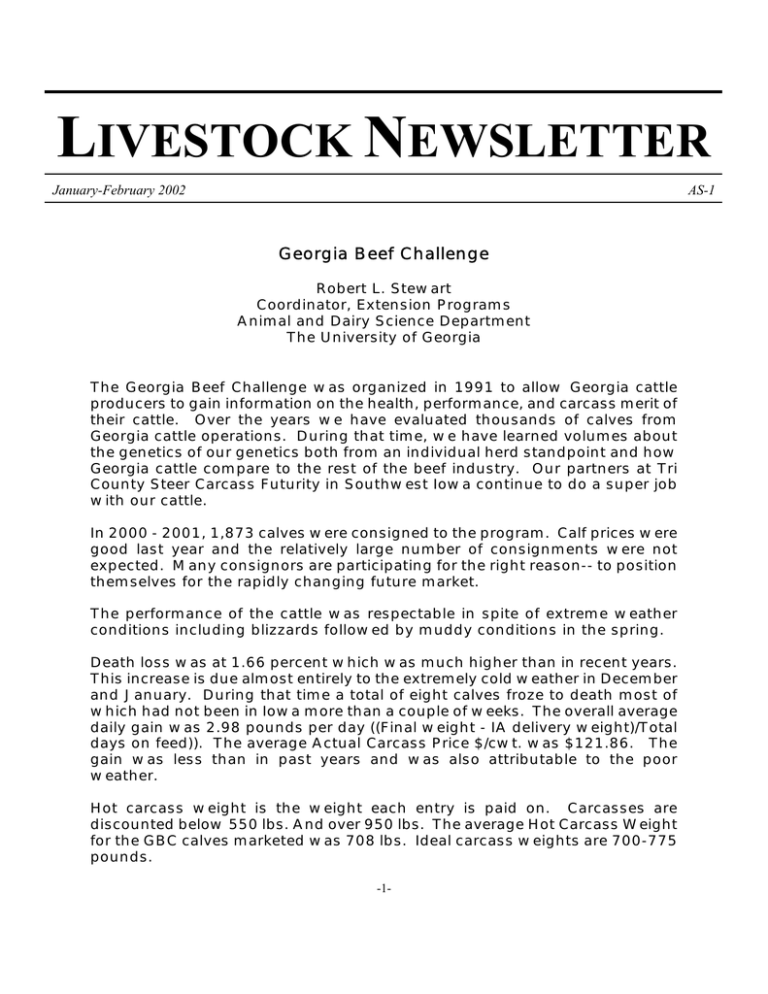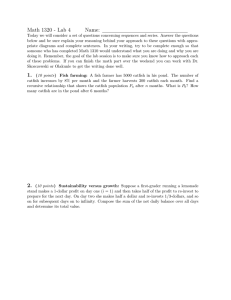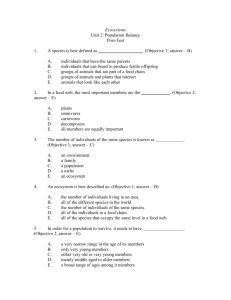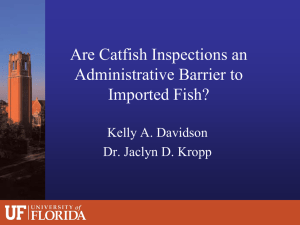L N IVESTOCK EWSLETTER
advertisement

LIVESTOCK NEWSLETTER January-February 2002 AS-1 Georgia Beef Challenge Robert L. Stewart Coordinator, Extension Programs Animal and Dairy Science Department The University of Georgia The Georgia Beef Challenge was organized in 1991 to allow Georgia cattle producers to gain information on the health, performance, and carcass merit of their cattle. Over the years we have evaluated thousands of calves from Georgia cattle operations. During that time, we have learned volumes about the genetics of our genetics both from an individual herd standpoint and how Georgia cattle compare to the rest of the beef industry. Our partners at Tri County Steer Carcass Futurity in Southwest Iowa continue to do a super job with our cattle. In 2000 - 2001, 1,873 calves were consigned to the program. Calf prices were good last year and the relatively large number of consignments were not expected. Many consignors are participating for the right reason-- to position themselves for the rapidly changing future market. The performance of the cattle was respectable in spite of extreme weather conditions including blizzards followed by muddy conditions in the spring. Death loss was at 1.66 percent which was much higher than in recent years. This increase is due almost entirely to the extremely cold weather in December and January. During that time a total of eight calves froze to death most of which had not been in Iowa more than a couple of weeks. The overall average daily gain was 2.98 pounds per day ((Final weight - IA delivery weight)/Total days on feed)). The average Actual Carcass Price $/cwt. was $121.86. The gain was less than in past years and was also attributable to the poor weather. Hot carcass weight is the weight each entry is paid on. Carcasses are discounted below 550 lbs. And over 950 lbs. The average Hot Carcass Weight for the GBC calves marketed was 708 lbs. Ideal carcass weights are 700-775 pounds. -1- The goal of the feeders has been to market a group of cattle with an average of 0.35 to 0.45 of fat cover. Our animals averaged 0.43. The ideal range of square inches of ribeye is 12 to 14 sq. inches; our average for the year was 12.1. The Calculated Yield Grade averaged 2.78 on a scale of Yield Grade 1 being lean and Yield Grade 4 being fat. Sixty-five percent of the Georgia Beef Challenge carcasses had a Quality Grade of Low Choice or better. Defects were found on only 8.5% of the animals. Defects included lung, trim, dark cutter, disposition, horns, rat tails, tremors, yellow fat, and condemned. The profit per head was $42.17 with an added income of $78,978.46 being generated for the Beef Challenge consignors. The range of Profit/Loss per head was from a loss of $875.18 to a gain of $381.24. Presently, there are 2163 calves on the 2001-2002 Georgia Beef Challenge. We have found that our genetics are as good as anywhere in the United States. We firmly believe that data and predictability will be important marketing factors in the years to come. Participants in the Georgia Beef Challenge will be in position to attract attention whatever might happen to the market. We now have some consignments for a March shipment. If you have calves you wish to consign, the contact your local county Extension Agent. He can furnish you with the entry information and preconditioning protocol to get your calves ready. -2- Catfish Farmer Certification Course at Tifton Gary J. Burtle Animal & Dairy Science - Tifton, Georgia After several requests for catfish farming training at the Tifton campus, a Catfish Farming Course was developed in order to train a number of people at one time. This course will cover many practical aspects of fish farming including economics, farm design, catfish feeding, catfish spawning, disease control, and water quality management. The first session of the five session course was held on January 12. This six hour session included catfish industry economics, business planning, catfish harvesting and transport, catfish processing, and marketing. After four hours of classroom instruction, the students were given demonstration of catfish transport and catfish processing. Each student received a notebook with 220 pages of relevant articles and a catfish budgeting spreadsheet. Five full day meetings will be held on Saturdays, January 12, February 9, March 2, April 20, June 15, 2002. 9:00 AM to 4:00 PM. Min 5, Max 10. Cost for the training is $100.00 per day, must attend a minimum of four sessions for certification. However, anyone can participate in the training. The titles and a brief description of content are as follows: Session I. Economics of catfish production, harvesting and marketing catfish products. Session II. Pond system design and water management. Session III. Catfish nutrition and feeding practices. Session IV. Catfish spawning and genetics. Session V. Aquatic nuisance control and fish diseases. Practical management methods will be presented in a classroom setting for part of each session followed by demonstrations and laboratory experience with actual catfish, equipment or software. Some course objectives will be accomplished using student teams to develop solutions to management questions. Students will gain proficiency in the use of record keeping and report generating software for fish farm management. Knowledge of equipment calibration, operation and maintenance will be gained in order to assure effective water quality management on catfish farms. Catfish nutrition, diseases, spawning, and environmental requirements will be learned so that decision making is based on the biological limits of the species. Make application to: Animal & Dairy Science Department, The University of Georgia, P. O. Box 748, Tifton, GA 31793-0748 For additional information contact: Dr. Gary Burtle, 229-386-3364, fish@tifton.cpes.peachnet.edu. -3- Monitor for further developments at: http://www.cpes.peachnet.edu/aquaculture/. -4- Determining the Sex of a Calf Timothy W. Wilson Animal & Dairy Science - Statesboro, GA Technologies involved in artificial insemination breeding programs have changed dramatically since AI began in 1780. Bull semen once stored in ampules can now be stored in straws, calving seasons can be tightened with estrous synchronization protocols, and estrus can be determined through the use of computerized estrus detection equipment. In the past, when traditional pregnancy checks were concluded, it was understood that the calf crop would yield about a 50:50 male:female ratio. This assumption was made knowing that the X-chromosome (egg) of the female would combine with either the X- or the Y-chromosome (sperm) of the male. This combination would result in either an XX (female) or XY (male) offspring. Now, however, current research reported in the 2002 Nebraska Beef Cattle Report indicate that with the use of emerging technologies, producers may eventually decide the sex of a calf using sexed semen. Through the use of sperm sorting equipment (SX Mo Flo, Cytomation, Inc., Ft. Collins, Colo.), researchers from the University of Nebraska, Colorado State University and XY, Inc. (Ft. Collins, Colo.) have been able to separate bull sperm up to 4,000 live sperm/sec. of each sex (Deutscher et al., 2002). Sorted sperm have a 90% accuracy rate and only a slight decrease in AI pregnancy rates compared to normal sperm (Deutscher et al., 2002). Although this technology has advanced in recent years, it has not reached the efficiency necessary to offer sexed semen commercially. As additional studies are completed and procedures are enhanced sexed semen may become commonplace. This technology as well as others offers exciting new alternatives for the innovative producer. If you have any questions regarding this topic, please contact your local county agent, or call me at (912) 6815639. Source: Deutscher, G., R. Davis, G. Seidel, Z. Brink, J. Schenk. 2002. Use of sexed (female) sperm is successful in yearling heifers. Nebraska 2002 Beef Cattle Report. Pg. 12-14. -5- Catfish Industry Update for 2002 Gary J. Burtle Animal & Dairy Science - Tifton, Georgia The catfish industry ended the year 2001 with much lower prices than had been recorded for any of the past 10 years. Look for rising prices during the coming year. Demand for catfish by consumers in 2001 increased over the demand for catfish in 2000. Processing volume in 2001 exceeded the volume of catfish processing in 2000 by about 5% even though about 15,000,000 pounds of new fillet imports were reported from Vietnam. Catfish cold storage inventories were down by about 8% in the last months of 2001 compared to 2000.In spite of an outstanding job of marketing catfish by the industry, prices to the producer fell from $.68 per pound at the end of 2000 to less than $.50 at the end of 2001. Continued demand for catfish can be credited to the lower prices demanded during 2001. At times of low price, the catfish industry expands its market share of seafood and meat markets. Catfish is now in the top five fish consumed in the United States. Imports of Vietnamese catfish have concerned the U.S. catfish industry in 2001. The volume of imports rose from about 400,000 pounds per month in early 2000 to nearly 2,000,000 pounds per month by mid-2001. The Vietnamese fish is called the Basa and its fillet looks much like the fillet of channel catfish. However, these Basa are classified in another taxonomic family and at the current time are cultivated in cages in the Mekong River. Because of visual similarities between Basa fillet and channel catfish fillet, a concern over proper labeling and 30% lower price of the Vietnamese fish has led the Catfish Farmers of America to consider filing an anti-dumping lawsuit against the Vietnamese. Federal legislation has been passed to specifically enforce the proper labeling of imported catfish. The decline in the U.S. economy has had a great effect on the declining price of catfish. Since imported catfish make up less than 5% of the processed catfish sold in the U.S., the largest factor affecting price is the economy. Job loss in major catfish consuming areas of the nation may be an important factor in reduced catfish sales in those areas. However, sales volume has not declined much in the nation as a whole due to the competitive pricing offered by catfish processors. According to USDA estimates, processor volume was more than 596 million pounds in 1999, more than 593 million pounds in 2000, -6- and was 553 million ponds in November with an expected volume of near 40 million pounds for December. Processors have been able to maintain volume of catfish supply at lower prices due to a larger inventory of process sized catfish on the farm. According to USDA estimates, inventories of small, medium and large food sized catfish are well above those of 2000 by almost 25%. A turn-around in catfish price is expected in 2002 due to depletion of inventories sometime after the first quarter of the year. Expansion of catfish acreage is expected to stop in 2002 due to relatively low catfish prices. A U.S. economic upturn could come as soon as the third quarter of 2002. Catfish imports failed to reach the 20 million pound mark predicted by 20% for 2001 and may be near their peak. Still, processing volume will have to increase in order to insure a price increase. New markets have been promised by new processing projects and those new markets are important to the continued growth of the catfish industry. Expansion of the Georgia catfish acreage slowed in 2001 due to falling prices and delays in development of a processing project at Wrightsville. Pond construction occurred mainly in the Jefferson county area with less than 100 acres being constructed outside of that county. One new catfish hatchery began construction in Jefferson county in 2001. Sales of catfish in Jefferson county continue at the rate of 20,000 to 40,000 pounds per week. As of the second week in January, sales of catfish have resumed in west Georgia at prices similar to mid-2001. A new processor intends to open the remodeled plant west of Albany with eventual capacity of more than 10,000 pounds per week. For more information about catfish and seafood market potential, please access the following web sites: www.st.nmfs.gov/st1/index.html - Fisheries Market News, wholesale market prices and frozen inventories. - Aquaculture Outlook and Catfish http://usda.mannlib.cornell.edu/usda Processors Report, catfish inventories in ponds twice each year and processor volumes by month. -7-






